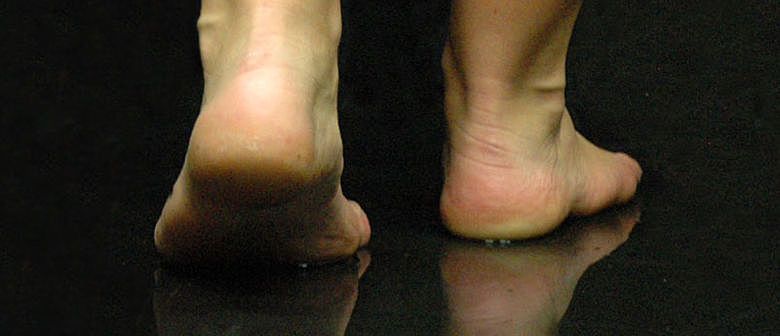Review: The Water Station
Using the training of Japanese Nō and Chinese Xiqu practices, The Water Station is a beautiful and compelling master class in simplicity.
The Water Station by Ōta Shōgo at BATS Theatre, directed by Megan Evans, is a theatrical event unlike any other you will have seen before. Using the training of Japanese Nō and Chinese Xiqu practices and workshops in Butoh, Evans and her cast of 16 performers tell many different stories as they slowly travel through the space, pass by and stop at a water station. Something terrible seems to have happened to all of them, but no definite answer is provided and I think it’s almost better if you don’t try to work it out. Just let them affect you. Each character and story is different and loaded with meaning, but none of them require any language in their telling.
The first character we see, The Girl (Kate Hounsell) possibly has the hardest job out of the cast, (and she wasn’t helped on opening night by a strangely delayed house lights fade). An animated audience suddenly falls quiet as we see her enter and then it is up to her to hold that audience and gently coax them into this performance. Like some kind of meditation, it feels quite alien until we tune in. Watching The Water Station, you feel yourself slowing down with the performers, relaxing into the rhythm of the piece. So much so that by the time the next characters, Two Soldiers (Amy Griffin-Browne and Travis Graham) enter and start to interact with each other and the water, it feels like metaphorical fireworks have gone off.
This production is working from Mari Boyd’s translation of Shōgo’s “script as document” which apparently reads like poetic stage directions. They have followed these as closely as possible, however Evans has chosen for her cast to perform at a slightly faster tempo than Shōgo’s prescribed 2 metres every 5 minutes. Nevertheless, even at this “faster” speed it still feels like a world completely out of time and place. The programme note tells us that the playwright’s artistic aim in theatre was to create a perspective of death by treating it as a framework for appreciating life. We only get a short glimpse of the lives of these travelers, but it feels like this world is one that keeps going on without us. While it might seem like nothing is happening at times, the amount we can learn about a character or a relationship from the tiniest movement or a simple glance seems to tell us more than a 10 minute scene with dialogue might achieve. The Married Couple (Tom Kereama and Katie Boyle), in particular, tell us so much more with tiny gestures than they ever could with dialogue.
Evans and her design team Debbie Fish (set design) and Rowan McShane (lighting design) have adapted to the BATS stage well. Having seen the original production last year at Victoria University’s Studio 77, this new space did feel quite claustrophobic in comparison to the conspicuous depth of the initial season. The Water Station feels like it needs room to breathe, something that can be easily achieved in the cavernous space of Studio 77. However, the intimacy of BATS Theatre offers something different and it is still exciting. The set is beautiful and the junk heap is more elegant this time using white fabric lit from beneath to great effect. The lighting creates a soft world around us and helps to shift the tone when needed, although the unfortunate and unavoidable spill from the corridor outside the theatre affected the end somewhat. The use of the music is essential in providing some kind of soundtrack and when the piece varies halfway through it offers a change of pace. The costume design by Helen Mackenzie and Kate Hounsell creates such a distinct world of nowhere and no time and yet connects all these characters together.
The performances are what really sell this piece to its audience. Slow motion seems to make everything more intimate and when a work is as pared back as this it relies on the actors to carry it. The concentration from the cast is impressive and they should all be commended on their intense focus and commitment to the form. There are a few standouts though who seem to be able to let the audience into their inner state with ease. Amy Griffin-Browne is dynamic from the moment she enters and Katie Boyle shows us so much sadness without seemingly doing anything. Michael Hebenton allows us moments of simple joy and Theo Taylor watching all of the proceedings from on high is a definite highlight. But it is Maggie White who really nails the emotional connection and lets us feel the suffering of these travelers.
Having seen several of Megan Evans’ productions for courses in the Theatre Programme at Victoria University, it is incredibly exciting that it is now playing in one of Wellington’s professional theatres. It is not often that work of this style is performed in this country, which is a shame as we have so much to gain from it. At times this production almost feels like a master class in simplicity, perhaps we too often try to do too much in theatre. Maybe we all just need to slow down and see what happens. If you are interested in performance or storytelling in any way, then you should definitely experience The Water Station; it is beautiful and compelling.
The Water Station plays at Bats Theatre from 22 April - 26 April
*
See also:
John Smythe for Theatreview


